Eric C. Sheninger's Blog, page 7
March 10, 2024
11 Ideas for Primary Math Stations
A few weeks back, I shared ideas on ELA stations for primary students after this was brought up during a coaching cycle with one of my schools. Upon reflection, I decided to do the same with math.
Creating math stations for primary students can be a fun and effective way to introduce them to basic math concepts through hands-on activities. These stations can help develop their understanding of numbers, shapes, patterns, and measurements in an interactive and engaging manner.
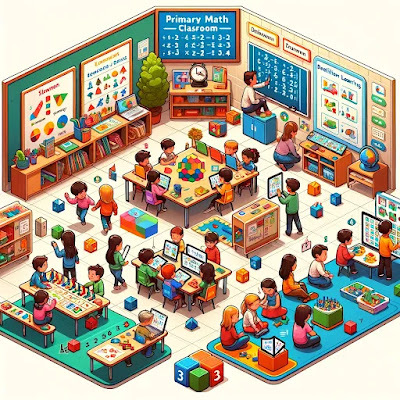
Here are some ideas for math stations suitable for students in PreK – 1st grade:
Counting: Practice counting and number recognition by having students use items like beads, blocks, or buttons for children to count. Include number cards so they match the quantity to the correct number.
Shape Sorting: Provide a variety of geometric shapes in different colors and sizes to identify and sort. Have children sort them by shape, size, or color into designated bins or onto labeled mats.
Pattern Making: Recognize and create patterns where students use colored beads, blocks, or stickers to create simple patterns. Encourage children to continue the patterns or create their own.
Measurement: Explore concepts of size and measurement by offering various items to measure with non-standard units, such as paper clips, blocks, or hands. Include activities like comparing the height of plants or the length of objects.
Simple Addition and Subtraction: Introduce essential addition and subtraction using visual aids like number lines, counting bears, or finger puppets to help children understand adding and taking away.
Number Writing: Practice writing numbers by providing dotted numbers for tracing, blank paper for free writing, and activities that involve writing numbers related to counting objects.
Math Storybooks: Combine literacy with math by selecting storybooks incorporating math concepts (e.g., counting, shapes). After reading, children can engage in related math activities or crafts.
Geometry Block Building: Understand spatial relationships and geometry by offering blocks of different shapes and sizes for accessible building. Challenge students with specific building tasks that require using certain shapes.
Graphing: Introduce data collection and representation by using simple graphing activities, such as graphing favorite fruits or the color of socks children are wearing. Provide stickers or stamps for children to fill in their answers on a chart.
Time Telling: Familiarize students with time using teaching clocks to show different times. Include puzzles that match times to daily activities (e.g., lunchtime, nap time).
Technology: This is a great way to integrate tech purposefully and acquire data using adaptive tools when appropriate. Use tablets or computers with ed-tech tools focused on math concepts, such as counting, simple addition/subtraction, measurement, shape sorting/identification, and patterns.
Each station can be adjusted to match the children's developmental level. It should be supervised to ensure that students grasp the concepts and to provide help as needed. Rotating the stations every few weeks can keep the activities fresh and engaging for the students. As with all station tasks, ensure that a sound pedagogical design is in place and that there is a targeted instruction or support rotation.

March 3, 2024
Relevant Thinking and Learner Success
In today's rapidly changing world, where new challenges and technologies emerge at an unprecedented pace, students need to be relevant thinkers to successfully navigate the complex social, economic, and environmental issues they will face. The ability to think relevantly enables them to connect classroom learning with real-world applications, fostering deeper learning and cultivating critical life competencies such as problem-solving, adaptability, and creativity. I shared the following in Disruptive Thinking in Our Classrooms:
In a disruptive world, learners need to be able to replace conventional ideas with innovative solutions to authentic problems.
As the future workforce will demand individuals who can apply knowledge in diverse and evolving contexts, relevant thinking empowers students to become effective problem solvers, innovators, and disruptive thinkers. It also ensures that education remains dynamic and meaningful, preparing students to make informed decisions and contribute positively to society. Hence, nurturing relevant thinking is essential for equipping young minds with the competence to transform knowledge into action and meet the demands of the future head-on.
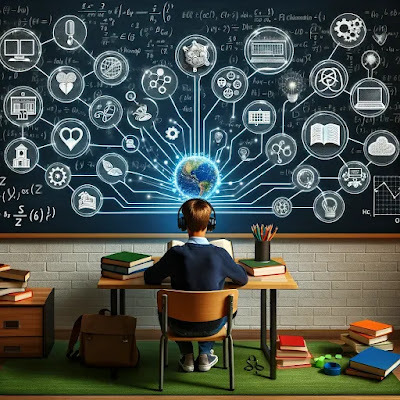
Relevant thinking in an educational context refers to connecting new knowledge and skills to real-world situations, making learning applicable to students' lives and future careers. It involves critical thinking directly related to personal experiences, societal issues, or practical applications.
Relevant thinking is essential in schools for several reasons:
Enhanced Engagement: When students see the relevance of what they are learning to their own lives and the world around them, they are more likely to be engaged and motivated.Improved Retention: Information connected to personal experiences or real-world examples is often retained more effectively because it becomes meaningful and is processed at a deeper cognitive level.Practical Application: Relevant thinking helps students understand how they can apply what they learn in school to solve real-world problems, a critical skill for their future careers and personal lives.Preparation for the Future: Schools are tasked with preparing students for the future. Relevant thinking ensures that the skills and knowledge they acquire are theoretical, practical, and applicable to future challenges. It also sets the stage for effective personalized learning. Encourages Lifelong Learning: When students practice relevant thinking, they develop a mindset that education is a continuous process that extends beyond the classroom, fostering lifelong learning.Development of Critical Competencies: Relevant thinking involves critical analysis, problem-solving, and decision-making skills, which are essential competencies for success in a disruptive world. These are all elements associated with deeper learning. Cultural and Social Awareness: Integrating relevant social and cultural issues into the curriculum can promote empathy, respect for diversity, and an understanding of global interconnectivity.In essence, relevant thinking helps bridge the gap between academic concepts and the real world, ensuring that education is not an isolated endeavor but a foundation for students to become effective, responsible, and active members of society.
The Relevant Thinking Framework is a powerful tool that educators can use to enhance learning outcomes by aligning teaching methods with how students learn most effectively. I changed the name as many educators, including myself, are not very fond of the word rigor in an educational context. However, the premise remains the same. This framework is structured around two dimensions: the Knowledge Taxonomy (vertical axis) and the Application Model (horizontal axis), each comprising four quadrants labeled A, B, C, and D.
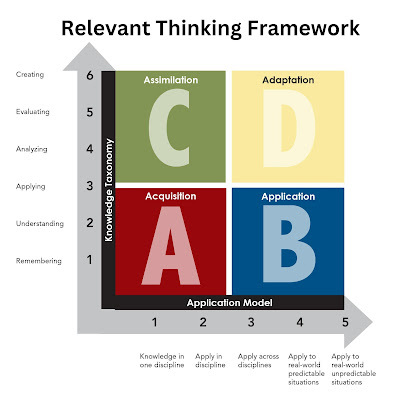
Here's how educators can leverage each quadrant to elevate student achievement:
Quadrant A - Acquisition: This quadrant focuses on foundational knowledge acquisition, where students recall and understand facts and principles. Educators should ensure students have a firm grasp of essential information in the classroom before progressing. Techniques such as repetition, mnemonic devices, and direct instruction are effective. However, moving beyond this quadrant is vital to applying knowledge in more complex ways.
Quadrant B - Application: Application refers to putting knowledge into action within familiar contexts. Educators can design activities where students apply what they've learned to solve problems or complete tasks. This might involve practical exercises, experiments, or real-life scenarios that require students to use their knowledge practically. For instance, math concepts can be reinforced through budgeting exercises or measuring ingredients in a cooking project.
Quadrant C - Assimilation: Here, students extend their thinking to analyze, evaluate, and create based on their knowledge. It encourages deeper cognitive processes and critical thinking. Educators can facilitate debates, research projects, or simulations that challenge students to synthesize information and form new understandings. It’s about making connections between different pieces of knowledge and seeing the larger picture.
Quadrant D - Adaptation: Adaptation represents the highest level of application, where students autonomously use their knowledge to tackle complex, real-world problems that may not have clear solutions. Educators should encourage project-based learning, interdisciplinary approaches, and creative problem-solving. In this quadrant, the role of the educator shifts from instructor to facilitator, providing guidance as students explore and innovate.
Educators should use the framework as a dynamic tool to scaffold instruction and assessment while moving to more personalized pedagogies. It can also be leveraged to ensure technology is used purposefully. Starting with Quadrant A, students can build a solid knowledge base, which serves as a springboard into higher-level thinking and application. Teachers should lead students through each quadrant, not necessarily linearly, but by providing opportunities to apply their learning in new and challenging ways. Moreover, the framework recognizes the importance of relevance in learning. For example, students are more likely to be engaged and motivated when they see the connection between standards and concepts to real-world applications. This engagement is critical for meaningful learning and retention.

Assessment is integral to the Relevant Thinking Framework. Educators should design assessments that not only measure recall of information (Quadrant A) but also the ability to apply knowledge in new contexts (Quadrants B and D) and the ability to think critically and create new ideas (Quadrant C). This means utilizing a mix of traditional tests, performance tasks, technology, portfolios, student reflections, and feedback.
The Relevant Thinking Framework is not a prescription but rather a guide for educators to design curriculum and instruction that meet students where they are and push them to where they need to be. It’s about recognizing that the ultimate goal of education is to prepare students to be thinkers, problem-solvers, and lifelong learners in an increasingly complex world. By using the framework thoughtfully, educators can create learning environments that raise standards and make learning relevant and exciting for their students.
February 25, 2024
10 Ideas for Primary ELA Stations
In my coaching work, suggestions typically arise for ideas on implementing various personalized strategies effectively at the primary level (PreK – 1). While choice, in my opinion, might not be the most developmentally appropriate option, I do see station rotation (or centers) as a viable option. Establishing engaging and educational station activities for primary-age students in the English Language Arts (ELA) curriculum is essential for fostering literacy skills, including reading, writing, listening, and speaking. Stations allow young learners to explore and practice these skills at their developmental level through purposeful play and hands-on activities. At the same time, the teacher can pull small groups for targeted instruction or support.
Recently, I was asked by some Kindergarten teachers at Howell Elementary School in Tennessee during one-on-one coaching sessions about ELA-specific stations that would be great for young learners. The conversation provided the spark for this blog post.
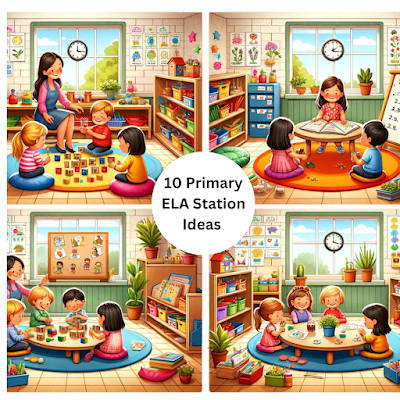
Here are several practical ideas that can be effective and enjoyable for primary students:
Sight Words Station: Little learners engage in tasks to recognize and practice high-frequency words. Implement interactive games like sight word bingo, memory match, and word fishing (using a small fishing rod with magnets to "catch" words written on paper fish).
Phonics and Word Families Station: Students learn to build phonemic awareness and understand word families. They can use sorting games where students group words by their beginning sounds or word family endings. Consider incorporating simple CVC (consonant-vowel-consonant) word-building activities with letter tiles or magnets.
Technology Station: Here is a great way to integrate digital literacy and acquire data using adaptive tools when appropriate. Use tablets or computers with ed-tech tools focused on ELA skills, such as letter recognition, phonics games, or digital storytelling tools.
Alphabet Station: Students learn to recognize and practice letters and sounds. Activities can include magnetic letters, alphabet puzzles, and letter-matching games. They can work on identifying letters, matching uppercase to lowercase, and producing letter sounds.
Listening Station: Students learn to develop listening comprehension and focus. Try setting up a listening center with headphones and a variety of age-appropriate audiobooks. Include follow-up activities related to the stories, such as drawing a scene from the story or answering simple questions.
Writing and Drawing Station: Students actively practice writing skills and express creativity. Provide various writing materials like paper, notebooks, pencils, markers, and crayons. Include prompts or story starters, and encourage students to draw pictures related to their stories.
Reading Nook: This station encourages a love for reading while improving fluency. Teachers can create a cozy corner with a range of picture books, early reader books, and thematic books related to current classroom topics. Rotate books regularly to keep the selection fresh and engaging.
Drama and Role Play Station: Students work to enhance speaking skills and imagination. Set up a mini-stage area with costumes, props, and puppets. Students can retell familiar stories, perform improvised scenes, or use puppets to create narratives.
Poetry and Rhyme Station: Your learners work to enjoy the rhythm and rhyme of language. Offer poetry books, nursery rhymes, and songbooks. Include activities like rhyming matching games, building simple rhymes, or creating class poems.
Sensory Writing Station: Students practice letter formation and fine motor skills. Provide trays with sand, shaving cream, or salt for students to write letters and words with their fingers or small writing tools.
For each station, it's essential to provide clear instructions and rotate activities regularly to keep students engaged and challenge their learning. Additionally, adapting each station to meet primary students' diverse needs and learning preferences will ensure that all children can participate and benefit from these ELA station activities. Here are some tips to help you develop station rotation effectively:
Develop a template and share it on-screen with contextIntegrate a timerUse available data to group/regroup and target instructionIntegrate an adaptive learning toolKeep rotations between 3-4Use an exit ticket (2-3 scaffolded questions/problems) at the end of the block for accountability
Effective and engaging ELA station activities for primary students are crucial for developing literacy skills. Although choice may only sometimes be developmentally appropriate for learners in PreK to Grade 1, station rotation offers a structured yet flexible method of instruction. These stations encourage skills ranging from letter recognition to creative expression and fine motor skills, all tailored to young learners’ developmental levels. Providing clear instructions and regularly updating activities are vital to maintaining engagement and addressing the diverse needs of the students.
February 18, 2024
Unlocking the Spectrum of Learning: The Multi-Faceted Magic of Personalization
We live in exciting times as unprecedented access to knowledge, research, and effective strategies at our fingertips can assist educators in creating meaningful experiences for students that align with both needs and strengths. One thing is for certain: learning is not linear. While a one-size-fits-all approach either worked for us or we just managed to get by, our connected world has shined a light on shifts that can be made to maximize students' time in class. Herein lies the power of personalization.
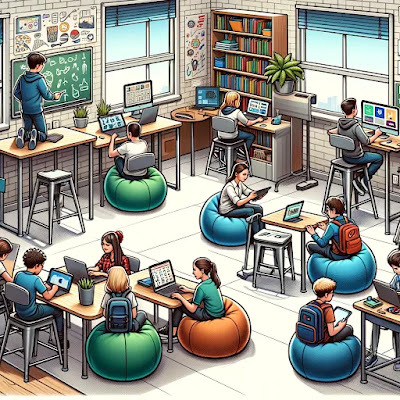
Now, let me clarify a few things. Personalization is all learners getting what they need, when and where they need it, to succeed. It’s not all students doing the same thing at the same time, the same way. It is also important to point out the following:
You don’t need technology to personalize learning.Putting all kids on a device simultaneously and having them watch a video or work on an adaptive learning tool is not personalization.There is not one best or right way to personalize.There are pathways that genuinely personalize learning for all students and there are uniform approaches that only focus on one aspect of high-agency practices. The latter is a common position of many vendors in the space. Herein lies why I outlined the three main points above. For personalization to fully flourish in ways that meet the needs of all, there should be a multi-faceted approach that strategically embeds voice, choice, path, pace, and place throughout lesson design and facilitation. This means looking at key practices such as Tier 1 instruction, pedagogy, assessment, feedback, differentiation, RTI, real co-teaching, and professional learning to see where there is an opportunity to grow.
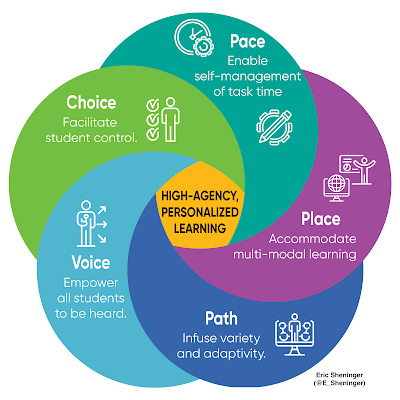
The above paragraph sets Quest Junior High School apart from many other, if not all, schools across the country and the world. It starts at the top with leadership. Principal Nicki Slaugh has engaged with her staff to create a shared vision and works tirelessly to provide support through feedback and professional learning. The consistent use of high-agency strategies and data has resulted in a myriad of ways to help address the needs of learners. In her words, there are no “cookie-cutter” ways to personalize. Keep this point in mind if and when you are looking to grow personalized practices in your district, school, or classroom.
While competency-based approaches buoyed by standards-aligned rubrics in the form of proficiency scales are the gold standard for path and pace, you will also see so much more. This includes using tech and whiteboard spaces for voice during Tier 1 instruction, choice activities, playlists, flipped lessons, stations determined by data, one-on-one conferencing, and maximizing flexible spaces. However, one aspect that sticks out is a consistent focus to impart high levels of cognition and relevance in all questions, tasks, and assessments. This is a testament to the staff at Quest, who see the value in personalization and not just another thing added to their plates.
Case in point. During a recent coaching visit, I had the opportunity to visit numerous classrooms with an emphasis on feedback for new teachers and growth in co-teaching practices, which has been a primary focus in year two of the work I have been facilitating. Before I highlight one teacher in particular, I must say that we saw exceptional personalized practices occurring throughout the school. This is yet another testament to the culture of learning that has been established. I was particularly impressed by first-year teacher Brylee Nelson’s English class. From my lens, you see clarity in the form of a standards-aligned learning target, a real-world application involving choice, high-level thinking in the form of a scaffolded rubric, and a closure task using technology that amplifies students' voices. While the students worked, Brylee was seen conducting individual conferences as a Tier 3 support.


Another standout for me was to see firsthand how much progress has been made with effective co-teaching strategies. Nicki and her teachers have worked so hard to grow in their area, and their accomplishments can serve as a model for other districts and schools. When you look at the image below, can you identify the four adults? It wasn't very easy for me at first. Data was used to establish the groups that were staffed by two teachers (math, SPED) and two teaching assistants. You would be hard-pressed to figure out their roles as they were all immersed in targeted support. MTSS, RTI, differentiation, and co-teaching are all established pathways to personalized learning when good data is available and leveraged effectively.

Supporting Quest and Nicki these past two years has been an absolute honor. You can see a snapshot of all they have accomplished HERE. When I created Aspire Change EDU, the main goal I set forth for the company was to ensure that all of our practice areas and solutions were tailored and customized to meet the needs of those I would serve. What this translates into is that there is no one way to personalize. While Quest had the best competency-based learning at scale I have ever seen in practice, which they established independently, Nicki saw opportunities to grow in other areas. The rest is now history.
To effectively personalize, we need to embrace a multi-faceted approach. Be wary of any solution, program, or professional development that doesn’t address all aspects of student agency while making connections to established practices that are known to be effective.
If you would like to learn more about how Aspire Change EDU can support your district, organization, or school or provide you with 1:1 coaching, feel free to reach out – AspireChangeEDU@gmail.com
February 11, 2024
What School Should Be
I vividly remember the first World Book Encyclopedia set my parents bought for the house in the early 1980’s. It was a sight to behold as what seemed like an infinite amount of knowledge was alphabetically organized, just waiting to be consumed. Housed in the dining room for ease of access by all, the copper and cream books with gold trim were a staple resource for my brothers and me when we had to do any research for school work. I even found myself perusing through the set randomly, looking to glean more insight into things that interested me. Without the encyclopedia set, our world was not very big. Little did we know, however, that the second these were published, they became irrelevant as new editions were already in print to keep up with the pace of new knowledge.
The Internet was still over a decade away, and when I got my first taste in the mid-1990s, I didn’t know how society would change forever. Flash forward many years, and we now have instant access to what seems like endless sources of information, which is both a good and bad thing, depending on perspective. I am of the opinion that endless scrolling through TikTok and over-snapping on Snapchat don’t always yield the best results when it comes to leveraging connectivity to learn. I digress. The rise of artificial intelligence has now put us in a new frontier of knowledge acquisition. You can even claim that the world is in the palm of our hands.
While the Internet drove the encyclopedia as we knew it to irrelevance, emerging technologies are having the same exact impact on traditional schooling. Virtually any student today can access knowledge and information. It’s what they can do with it in a meaningful way that they crave. This was reinforced to me recently when I met with a group of high school students in New York. During our conversation, they stressed the need for relevant learning and a more significant purpose, something that isn’t always emphasized in the curriculum. The image below captures the essence of what school should be in the eyes of those we serve.

Now, I am not saying that knowledge and recall don’t have their place. They certainly do, especially at the lower elementary level. However, we need to ask ourselves what was gleaned of value from our experiences being “schooled” and then put ourselves in the shoes of our learners who have powerful computers in their pockets, access to AI, and can create elaborate content on a drop of a dime. Yes, they still need teachers, even more so than in the past, who can help them construct new knowledge, self-regulate, overcome challenges, and see connections to what is learned in a real-world context. What they need less of is content dissemination, where passive consumption and regurgitation of facts have limited value in a disruptive world.
Change is hard. Without honesty and vulnerability, it becomes even more difficult. While present challenges still remain in the form of time and a focus on standardized test scores, we must look for opportunities to honor students' voices and help them develop the competencies to engage in work that matters. This means personalizing the curriculum in ways that connect to what matters. While the tasks depicted in the image above are certainly important, we can’t discount the importance of competencies that will allow learners to thrive now and well into the future. In Disruptive Thinking in Our Classrooms, I identified six of these, which you can see below.

As I reminisced about the bygone era of encyclopedias, the purpose was to chart our journey to the present, where the Internet and artificial intelligence have revolutionized access to knowledge. It’s time for a fundamental transformation in education from the passive intake of information to a system emphasizing relevance, purpose, and the practical application of knowledge. Conversations with students confirm the craving for education that aligns with real-world needs and enables meaningful contributions. The time is now to evolve beyond traditional roles, fostering competencies that empower students to proactively navigate and shape the future. It calls for personalized curricula that respect and amplify student voices, preparing them for a world where adaptability, creativity, and critical thinking are paramount. Are you in?
January 28, 2024
Cultivating Leadership: Strategies for Building Capacity
In the ever-evolving landscape of education, the role of leadership is pivotal. The notion of educational leadership extends beyond administrative responsibilities; it embodies the vision, direction, and ethos of a learner-centric environment. Building capacity is not just an individual pursuit but a collective journey towards excellence. It is vital because it directly impacts the quality and effectiveness of teaching and learning environments.

Strong leadership fosters a culture of continuous improvement, innovation, and collaboration, which are essential for adapting to a disruptive world. Influential leaders guide and inspire their teams and play a crucial role in shaping educational policies and practices that meet diverse student needs. By investing in leadership development, educational institutions ensure they are equipped to overcome challenges, maximize student achievement, and prepare learners for success in an increasingly complex world. This investment in leadership is an investment in the future, as it empowers educators to create positive, lasting changes within their schools and communities.
Understanding the Role
Leadership is about action. It is not confined to principals or central office administrators; it includes anyone who takes on a leadership role within an educational setting. This includes teachers, department heads, and even students. Understanding that leadership can come from various levels within an educational system is crucial in fostering a culture of shared responsibility and empowerment.
"Leadership isn't telling people what to do. It’s taking people where they need to be by empowering them to want to be part of the solution."
Developing a Shared Vision
A shared vision is the cornerstone of effective leadership. It provides a clear direction and purpose, aligning the efforts of all stakeholders. Developing this vision involves inclusive dialogue, where the contributions of teachers, students, parents, and community members are valued. Shared visions are the ones that truly resonate and they are formed only when you pay close attention to others, understand their aspirations, and address their requirements. Exceptional leaders successfully lead their teams toward the future by engaging in the most fundamental form of research: observing and understanding human nature. A shared vision guides the institution and fosters a sense of belonging and commitment among its members.
Investing in Professional Learning
Building leadership capacity requires continuous learning. This can be achieved through formal training programs, workshops, job-embedded coaching and conferences. Equally important are informal learning opportunities like peer mentoring, collaborative projects, and reflective practices. Education leaders should be lifelong learners, constantly seeking to enhance their skills and knowledge. The overall goal, however, should be efficacy, where you can show the impact of investments made in professional learning.
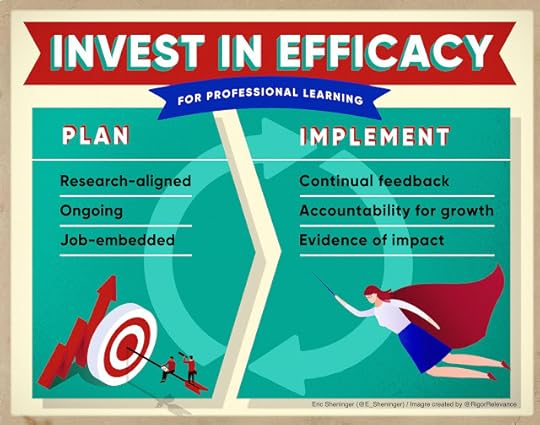
Encouraging Collaborative Leadership
Collaborative leadership is essential in the educational context. It involves distributing leadership responsibilities, encouraging teamwork, and fostering a culture of trust and respect. By valuing the input of all members, collaborative leadership empowers individuals, harnesses diverse perspectives, and promotes a more inclusive decision-making process.
Fostering a Culture of Innovation
Educational leaders should cultivate an environment where innovation and creativity are encouraged, something I elaborate on in great detail in Digital Leadership. This involves being open to new ideas, experimenting with different teaching methods, and embracing technological advancements. A culture of innovation is crucial for adapting to the changing needs of students and the wider community. True leaders recognize that their achievements are reliant on the collective success of their team, rather than building a group of followers or disciples. They are aware that victories in wars, elections, or football games are not the result of a single individual's efforts, but rather the outcome of collaborative teamwork.
Emphasizing Emotional Intelligence
Emotional intelligence is a critical component of effective leadership. Leaders in education must be able to understand and manage their emotions, as well as empathize with others. This competency is vital in building strong relationships, managing conflict, and creating a supportive learning environment. Leaders who prioritize emotional intelligence forge deeper connections, inspire greater trust, and create more resilient teams, turning empathy and understanding into a cornerstone of successful leadership.
Leading by Example
Effective leaders lead by example. They demonstrate the values, attitudes, and behaviors they wish to see in their institutions. This includes showing commitment, integrity, and a passion for education. Show everyone what it means to be a good leader by being a good follower. Set a positive example through your own actions and work ethic. Basically, don't ask others to do what you have not or are not willing to dio yourself. Leaders who embody these qualities inspire others and create a positive and productive learning environment.
Building educational leadership capacity is a dynamic and continuous process. It requires a commitment to shared vision, professional growth, collaboration, innovation, emotional intelligence, and leading by example. By embracing these strategies, educational leaders can create environments that not only foster academic success but also nurture the development of future leaders. The journey of building leadership capacity is one of transformation and growth for the individual leader and the educational community they serve.
Interested in learning more about building leadership capacity? If so, check out the workshop and coaching options at Aspire Change EDU and let's set up a Zoom call - esheninger@gmail.com
January 7, 2024
System for Educational Transformation (SET)
As we navigate the shifting currents of the educational landscape, it's clear that transformative change is not just necessary—it's inevitable. To foster an environment where every student thrives, we must reimagine our approach to education from the ground up. This calls for a system that is not just a patchwork of quick fixes but a comprehensive blueprint for enduring change. Such a system would not only address the immediate challenges but also lay down the groundwork for long-term evolution. It intertwines innovative teaching practices, cutting-edge technologies, and a culture of inclusivity into the very fabric of districts and schools. Herein lies the rationale for why I created the System for Educational Transformation (SET) at Aspire Change EDU.
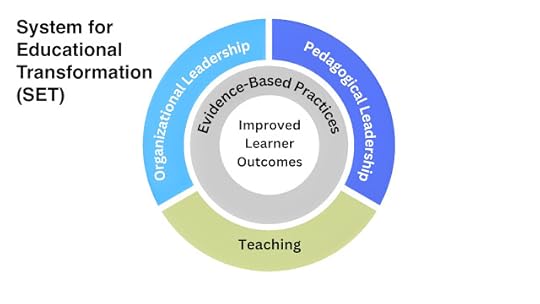
By prioritizing adaptability, engagement, and evidence-based strategies, this system promises to reshape the educational experience. It's a holistic vision that empowers educators, inspires students, and aligns with the ever-evolving demands of society, ensuring that the leaders of tomorrow are nurtured in classrooms that reflect the potential of their futures. As we embark on this journey of transformation, the system for change will serve as our map and compass, guiding us toward a redefined horizon of educational excellence.
SET grounds everything we do at Aspire Change EDU. All services and offerings that we provide support longitudinal and evidence-based change to improve learner outcomes backed by research. Below is more detailed information on the components of the system.
Organizational leadership is a multifaceted and critical component of ensuring the success of educational institutions. Several key aspects underpin effective leadership in this context. Firstly, visionary leadership is essential, as it sets the direction and long-term goals for the district. A strong leader should also be capable of fostering a collaborative and inclusive culture that values diversity and promotes equity in education. Effective communication is vital, as it ensures that all stakeholders, including teachers, parents, and students, are well-informed and engaged. Additionally, strategic planning and resource management are central to optimizing educational outcomes within budget constraints. School district leaders must also be adaptable and able to navigate the ever-evolving landscape of education, including new technologies and pedagogical approaches. Lastly, a commitment to continuous improvement and data-driven decision-making is essential to drive positive changes and enhance the quality of education for all students within the district. The Pillars of Digital Leadership, Comprehensive Needs Assessment (CNA) and associated rubrics serve as springboards to move organizational leadership to the next level.
Pedagogical leadership in schools plays a pivotal role in shaping the quality of education and fostering a culture of continuous improvement. Several key aspects are integral to effective pedagogical leadership. First and foremost, a pedagogical leader must be deeply knowledgeable about educational theory and practice, staying abreast of the latest research and innovations in teaching and learning. They should also have a keen understanding of the unique needs and abilities of their students and be adept at tailoring instruction to meet those needs. In addition, fostering a collaborative and supportive environment for teachers is crucial, as it empowers educators to excel in their roles and encourages professional growth. Pedagogical leaders should also prioritize student-centered approaches, ensuring that teaching methods align with the individual learning styles and interests of students. Regular assessment and data-driven decision-making further support the development and implementation of effective teaching strategies. In sum, effective pedagogical leadership empowers educators and creates an environment that maximizes student learning and achievement. The Framework for Pedagogical Leadership and our personalized approach to Professional Learning Communities (PLCs) serve to build capacity in this area.
Effective teaching is a dynamic endeavor that revolves around several key aspects. A deep and up-to-date knowledge of the subject matter is essential, as it provides the foundation for effective instruction. Clear communication and the ability to convey complex concepts in an understandable manner is crucial, as it ensures that students grasp the material. Adaptability and differentiation are also important, as effective teachers tailor their approach to meet the diverse needs and learning styles of their students. Furthermore, classroom management skills help create a positive and conducive learning environment while fostering student engagement and motivation, which is vital for sustained interest in the subject matter. Assessment and feedback play a significant role as they guide instruction and enable both teachers and students to track progress and make necessary adjustments. Finally, a commitment to ongoing professional development and a genuine passion for teaching are central to ensuring that students receive a high-quality education that prepares them for future success. Using the Rigor Relevance and Personalized Learning Frameworks, teachers and leaders will be immersed in high-effect strategies to empower learners.
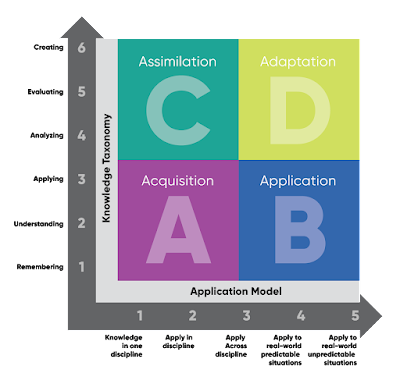
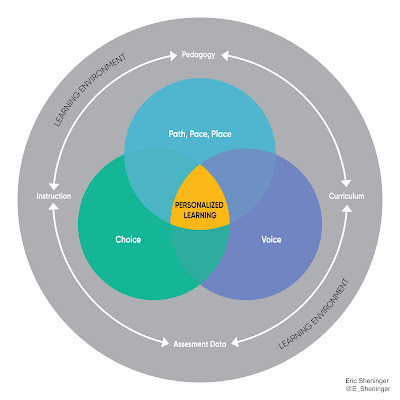
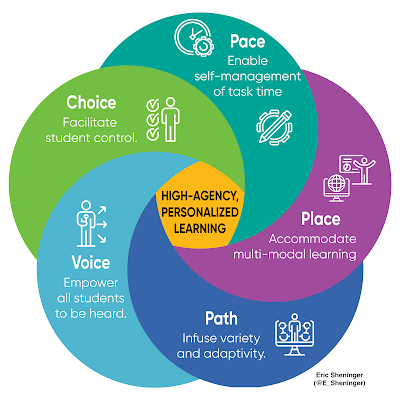
The importance of evidence-based practices in K-12 education cannot be overstated. These practices are grounded in empirical research and data-driven insights, ensuring that instructional methods, curriculum choices, and educational policies are based on what has been proven to work. By relying on evidence, educators can make informed decisions that enhance student learning and achievement. It allows for the implementation of teaching strategies that have been shown to be effective, thereby optimizing the educational experience for students. Furthermore, evidence-based practices help in the equitable distribution of resources and support as they identify and address the specific needs of different student populations. They also promote accountability in education, enabling educators and policymakers to assess the impact of their efforts and make necessary adjustments. In a rapidly changing educational landscape, evidence-based practices serve as a compass, guiding the way toward better outcomes for students and contributing to the continuous improvement of K-12 education.
Our consultants at Aspire Change EDU, personally trained by me, possess practical experience in effective teaching, pedagogical leadership, and organizational leadership. Each one has successfully implemented aspects of SET backed by impressive results related to evidence-based practices leading to improved learner outcomes.
In the realm of K-12 education, the compass of evidence-based practice is indispensable, guiding districts, schools, and organizations through the ever-evolving landscape of effective methodologies and curricular designs. Grounded in the solid bedrock of empirical research, these practices shine a light on the pathways that lead to enhanced student learning and achievement. They serve as the critical lens through which educators evaluate the efficacy of their methods and professional learning, ensuring that every strategy is measured and every policy decision is informed. As educators navigate the complexities of diverse student needs and the equitable allocation of resources, evidence-based practices stand as beacons of accountability, shining forth insights gleaned from data and research. In a field that is as dynamic as it is vital, these practices are the stars by which educators chart their course, striving unwaveringly for the betterment of educational outcomes and the continuous advancement of K -12 education.
Want to learn more? Reach out today (aspirechangeEDU@gmail.com).
December 31, 2023
Top Posts of 2023
As we reflect on the past year, it's evident that the realm of education continues to be influenced by an array of disruptive forces, most notably artificial intelligence. Through my writing, I have attempted to capture the essence of contemporary challenges and innovations but also provide practical solutions and thought-provoking insights from the field. From exploring the nuances of a post-COVID world to offering fresh perspectives on traditional teaching methodologies, each post has been a testament to my commitment to advancing educational discourse. My writing style, blending analytical depth within relevant contexts, strives to serve a diverse audience of educators, students, and academic enthusiasts, making ideas understandable and relevant to all educators.
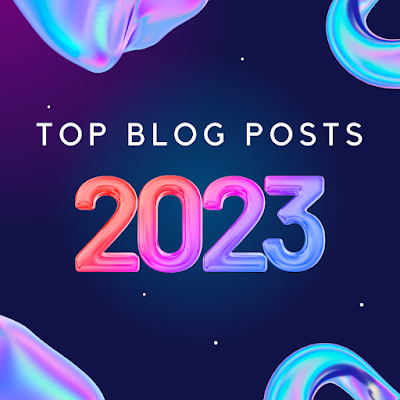
Key posts have delved into the transformative potential of technology in classrooms, the importance of personalized learning in education, building leadership capacity, and the evolving dynamics of teacher-student interactions in a post-pandemic world. My sincere hope is that these articles have not only resonated with readers but have also sparked meaningful discussions and inspired actionable change in educational settings. Through my blog, I've aimed to create a platform that not only informs but also empowers and motivates educators and learners to explore new horizons in education.
For the past fourteen years, my journey as a blogger in has been an enriching experience, marked by a relentless pursuit of knowledge and a passion for sharing it with the world. Without further ado, I hope you enjoy my top posts of 2023. As I have done the past couple of years, I am including a hyperlink and the related image. I wish you all a happy and safe holiday season. Here’s to an amazing 2024!
A Framework for Learning Through the Purposeful Use of Technology

10 Ways to Grow as a Pedagogical Leader

Artificial Intelligence for Leaders

5 Clear Ways Digital Benefits Learners


December 17, 2023
Connecting the Dots: The Power of Relational Learning in Shaping Tomorrow's Minds
In the ever-evolving personalized landscape, relational learning emerges as a fundamental component. At its core, it underscores the importance of building connections between concepts fostering a deep and interconnected understanding of subjects. However, the significance of relational learning extends beyond the academic realm, as it emphasizes cultivating relationships among students and educators centered on trust.
Relational learning matters because it addresses the shortcomings of traditional memorization-based approaches, something we have emphasized as a critical tenet of personalization. Rather than viewing topics in isolation, this method encourages students to explore the interconnectedness of ideas. Students develop the necessary thinking skills essential for success in academic and real-world scenarios by recognizing and understanding relationships between concepts. Drawing connections between seemingly disparate pieces of information enhances comprehension and retention, providing a foundation for lifelong learning.
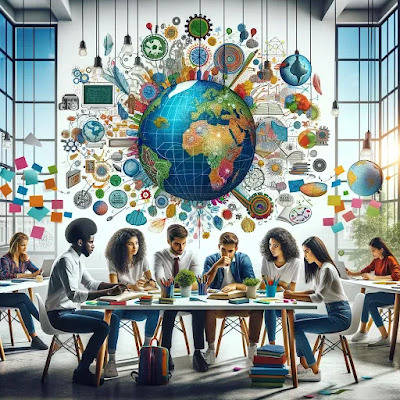
Beyond its cognitive benefits, relational learning contributes to creating a positive and collaborative classroom environment. Building relationships among students and between students and teachers is a crucial aspect of this approach. When students feel a sense of connection and trust, they are more likely to engage in meaningful discussions, share ideas, and collaborate on projects. These interpersonal skills are essential for academic success and mirror the professional world's collaborative nature, where effective teamwork is highly valued.
“Without trust, there typically is no relationship. Without relationships, little to no meaningful learning or progress occurs.”
To implement relational learning effectively, educators must prioritize establishing positive relationships within the classroom. Creating a supportive and inclusive environment where students feel comfortable expressing their thoughts and opinions is paramount, which is why learner voice matters. Educators can achieve this by fostering open communication, actively listening to students, and demonstrating genuine interest in their individual journeys. Building relationships also involves recognizing and appreciating the diverse backgrounds, experiences, and learning preferences present in the classroom, fostering an inclusive atmosphere that celebrates uniqueness. Click HERE to learn more about how to build relationships effectively.
In addition to building relationships, successful implementation of relational learning requires thoughtful curriculum design and instructional strategies. Incorporating real-world examples, purposeful play, case studies, and interactive activities highlighting the relationships between concepts can make learning more engaging and relevant for students. Technology can also play a crucial role by providing multimedia resources to explore and understand interconnected ideas.
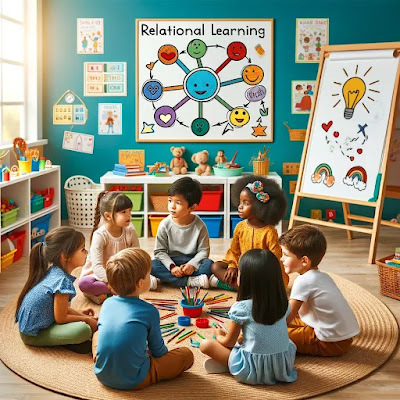
Assessment methods should align with the principles of relational learning, emphasizing understanding and competency development over rote memorization. Assessments can include tasks that require students to demonstrate their ability to identify and articulate relationships between concepts. This shift in assessment encourages students to develop analytical skills and reinforces the value of relational learning in their academic journey.
While this all seems daunting, there is a framework available that any educator can use to create a shared vision, language, and expectations regarding relational learning as a means to enhance personalization. The Rigor Relevance Framework can be used to develop and analyze questions, tasks, and assessments to ensure an appropriate amount of challenge and purposeful learning application. Below are a series of images that can be used to evaluate and reflect on your practice.
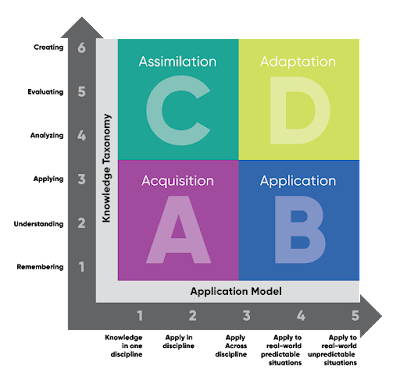
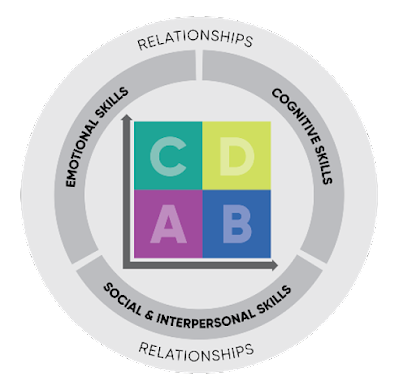
Relational learning is a cornerstone of personalization, promoting cognitive development and establishing meaningful relationships within the classroom. The successful implementation of this approach involves a dual focus on curriculum design and the intentional cultivation of positive relationships. By prioritizing relational learning and building connections within the classroom, educators can create an environment that nurtures holistic understanding, critical thinking, and interpersonal skills essential for success in both academic and real-world settings.
December 3, 2023
The Role of Place in Personalization
The physical and virtual environments where learning takes place play a pivotal role in shaping the effectiveness and depth of personalized learning strategies. Consider for a moment the impact of the physical classroom. It is not merely a backdrop but an active participant in the learning journey. The arrangement of desks, the presence of collaborative spaces, and the infusion of technology all contribute to the atmosphere that shapes a student's educational experience. As you delve into personalized learning, the importance of tailoring these spaces to accommodate diverse learning needs becomes increasingly evident.
Research consistently underscores the profound impact of physical and virtual learning environments on educational outcomes. According to a study by Tanner and Lackney (2006), the design of physical spaces significantly influences student engagement and academic performance. Flexible seating arrangements, varied learning zones, and interactive elements have been found to correlate positively with increased student motivation and collaboration (Tanner & Lackney, 2006). Furthermore, research by Hattie (2012) emphasizes the importance of creating a positive classroom climate, asserting that the physical layout plays a crucial role in fostering a conducive atmosphere for learning. The influence of virtual learning environments cannot be ignored either. A Means et al. (2013) meta-analysis highlighted the importance of well-designed online platforms, emphasizing their impact on student achievement and satisfaction. As the digital landscape continues to evolve, understanding and optimizing physical and virtual learning spaces is paramount for educational success (Means et al., 2013; Hattie, 2012; Tanner & Lackney, 2006).
Physical Learning Spaces
The traditional classroom setup, with rows of desks facing forward, may not be the most conducive environment for personalized learning. Flexible seating arrangements, breakout spaces, and interactive learning corners empower students to take control of their learning. Recognizing that each student is unique, physical spaces can be designed to cater to various learning preferences, whether it be quiet individual study, collaborative group work, or hands-on experimentation.
Virtual Learning Environments
In our digital age, the concept of place extends beyond physical boundaries. Virtual learning environments, online platforms, and educational apps contribute to the personalized learning ecosystem. The design of these digital spaces, from user interface to interactive features, can significantly influence the engagement and success of personalized learning initiatives. Thoughtful consideration must be given to user experience and accessibility, ensuring the virtual place complements and enhances the learning process.
Outdoor Areas
The importance of outdoor spaces for learning cannot be overstated, as they offer a transformative and holistic dimension to education. Beyond the traditional confines of classrooms, the outdoors provides a dynamic setting that stimulates curiosity, creativity, and a sense of exploration. Nature becomes a powerful teacher, offering biology, ecology, and environmental science lessons in a living laboratory. Beyond academic subjects, outdoor spaces promote physical activity, contributing to students' overall well-being. The fresh air and natural light create an invigorating atmosphere, fostering focus and reducing stress. Moreover, outdoor environments encourage collaboration, teamwork, and social skills as students engage in activities that often require cooperation and communication. By integrating outdoor spaces into the learning experience, educators enrich the academic curriculum and cultivate a love for the environment and a deeper connection to the world around us.

Below are some specific strategies for crafting effective learning spaces:
Individualized Learning Zones: Break down traditional classroom barriers by creating individualized learning zones. Each student can have a designated space that aligns with their preferred learning style, whether a quiet corner for reflection or an interactive area for hands-on exploration.Technology Integration: Leverage technology to bridge the physical and virtual learning spaces. Interactive whiteboards, digital collaboration tools, and online resources can seamlessly integrate into the classroom, providing a dynamic and personalized learning experience.Flexible Furniture: The days of static desks and chairs are behind us. Embrace flexible furniture that can be easily rearranged to accommodate different learning activities. This adaptability promotes a sense of ownership over the learning environment.Makerspaces: When I hired Laura Fleming in 2012, I asked her to transform the library into a place where kids not only wanted to read but could also serve as a catalyst for personalization. She did all that and more by creating a makerspace that became revered by our students and educators across the globe. It was a place for learners to collaborate, hack, invent, share, create, make, and do, which is the epitome of personalization. They were given all the tools needed to get started, but where it went was up to them. Learn more about makerspaces HERE.Student-Centric Design: Involve students in the design process. Solicit their input on the classroom layout, the choice of furniture, and technology integration. A student-centric approach ensures that the learning space truly resonates with its inhabitants.As you embark on the personalized learning journey, consider the impact of place. The physical, outdoor, and virtual environments in which learning unfolds are not passive backdrops but active participants in the educational process. By strategically crafting these spaces to align with the diverse needs of learners, we can amplify the effectiveness of personalized learning initiatives. The power of place extends beyond the confines of walls and screens; it is a dynamic force shaping the essence of how we learn and grow.
Hattie, J. (2012). Visible learning for teachers: Maximizing impact on learning. Routledge.
Means, B., Toyama, Y., Murphy, R., & Baki, M. (2013). The effectiveness of online and blended learning: A meta-analysis of the empirical literature. Teachers College Record, 115(3), 1-47.
Tanner, C. K., & Lackney, J. A. (2006). Approaches to learning space design. Planning for Higher Education, 34(3), 35-50.



